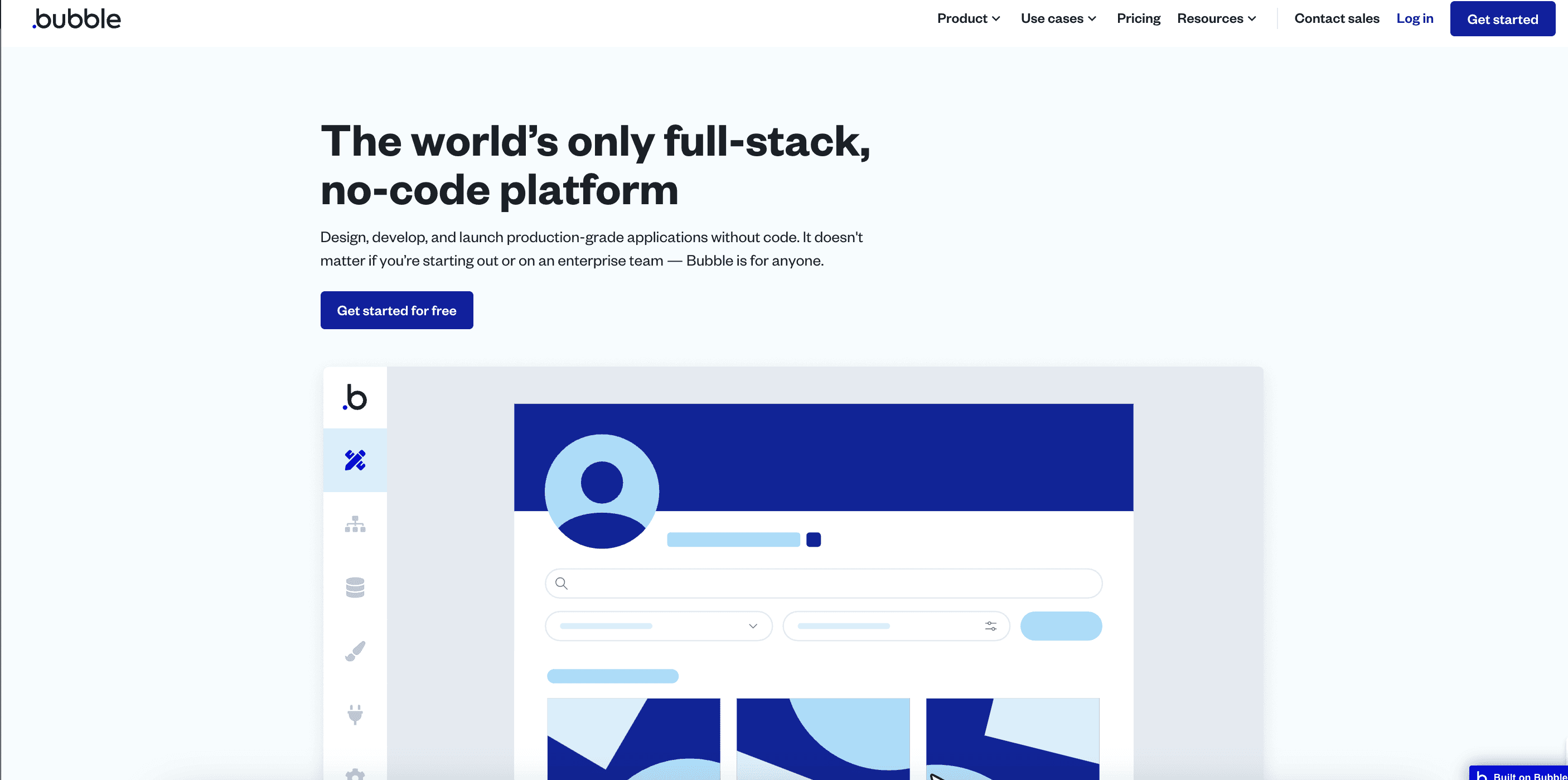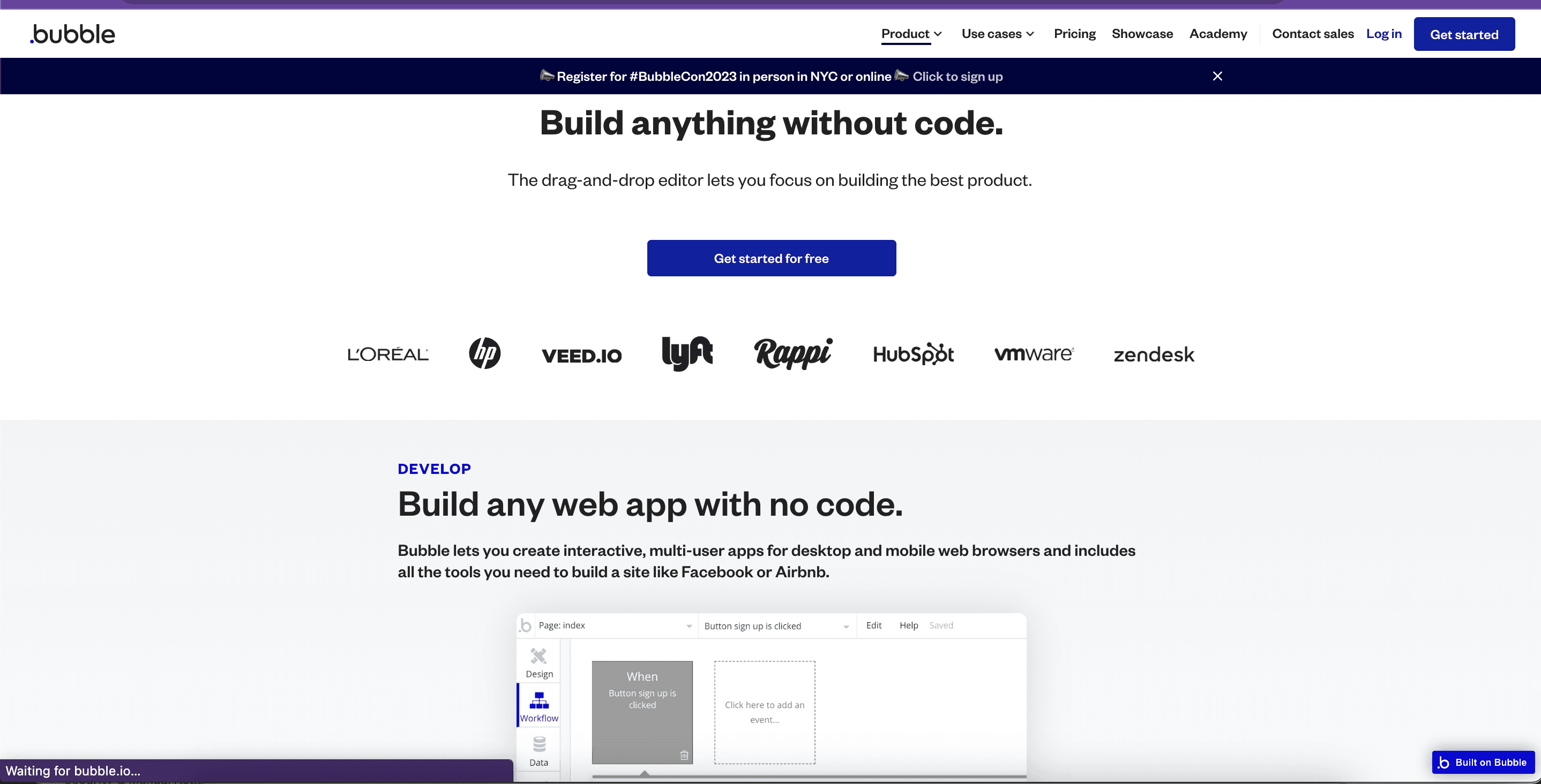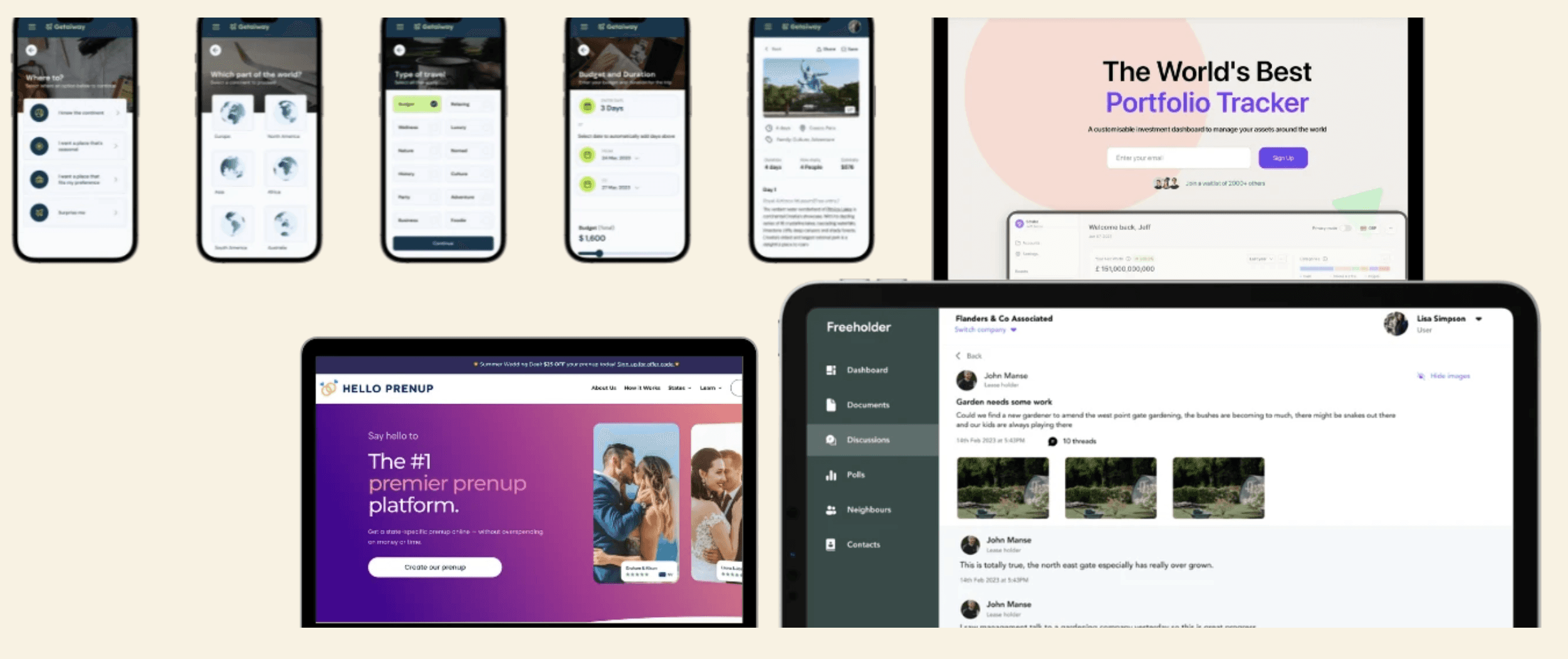Traditionally, app development remained largely inaccessible due to the technical barrier posed by coding language requirements, hindering individuals with innovative ideas but limited programming expertise.
The emergence of no-code development platforms has significantly democratized the process, with Bubble standing at the forefront of this transformative movement. This article delves into the mechanisms by which Bubble facilitates the democratization of app development, making it accessible to a diverse range of individuals and transforming the way we approach creating web applications.
Understanding Bubble:

Bubble stands as a powerful no-code development platform, redefining the conventional norms of app creation. At its core, Bubble empowers users to design, develop, host, and scale applications without the need for extensive coding skills.
Bubble is designed with simplicity in mind, offering an intuitive visual interface that allows users to build complex web applications through a drag-and-drop approach. This eliminates the need for intricate coding, making it accessible to individuals with varying technical backgrounds. The platform boasts a range of pre-built elements and workflows, enabling users to focus on the functionality and design of their applications rather than getting bogged down in the intricacies of code.
Features and Capabilities that Make Bubble User-Friendly

Visual Interface: Perhaps the most distinctive feature of Bubble is its intuitive visual interface. Users interact with a canvas where they can place elements and define workflows visually. This drag-and-drop approach not only simplifies the development process but also makes it more engaging and accessible to those who may not have a coding background.
No-Code Logic Building: Bubble excels in allowing users to build complex logic without writing a single line of code. Through a visual workflow editor, users can define conditions, actions, and data manipulations. This no-code logic building is pivotal in ensuring that the platform caters to a wide audience, from entrepreneurs to hobbyists.
Extensive Plugin Ecosystem: To enhance the functionality of applications, Bubble offers a rich ecosystem of plugins. These plugins cover a wide array of functionalities, from integrating third-party services to adding advanced features. This extensibility ensures that users can augment their applications without delving into complex coding or API integrations.
Responsive Design: Bubble places a strong emphasis on creating responsive designs for web applications. The platform allows users to build interfaces that adapt seamlessly to various screen sizes, ensuring a consistent and user-friendly experience across devices.
Comparison with Traditional Programming Environments

In contrast to traditional programming environments, where proficiency in coding languages is a prerequisite, Bubble distinguishes itself through its approach to application development.
Accessibility: Traditional programming often poses a steep learning curve, requiring individuals to invest time in mastering coding languages. In contrast, Bubble's visual interface and no-code logic building empower users to start creating functional applications with minimal learning overhead.
Rapid Prototyping: Traditional programming may involve lengthy coding and debugging cycles. Bubble accelerates the development process by enabling rapid prototyping. Users can iterate quickly, making adjustments in real-time and seeing the immediate impact on their applications.
Democratization of Development: Traditional programming environments can be exclusive, limiting app development to those with coding expertise. Bubble breaks down these barriers, democratizing development and allowing individuals from diverse backgrounds to participate actively in creating software solutions.
Scalability: While traditional programming is renowned for its control and customization, it often requires extensive coding for scalability. Bubble, on the other hand, provides scalability without the need for intricate coding, making it suitable for projects of varying sizes and complexities.
How Bubble Democratizes Web Development

Bubble is not merely a development platform; it is a catalyst for democratizing web development, fundamentally altering the landscape of who can participate in creating sophisticated web applications.

Elimination of Coding Barriers:
Traditionally, web development has been synonymous with coding expertise, creating a barrier that excluded individuals with diverse backgrounds from actively contributing to the creation of digital solutions. Bubble disrupts this paradigm by offering a no-code environment where the visual interface takes precedence over complex coding syntax.
The elimination of coding barriers is manifested through a drag-and-drop interface, visual workflows, and a logic builder that allows users to define intricate functionalities without writing code. This approach not only accelerates the development process but also opens the door for a broader audience, including entrepreneurs, designers, and domain experts, to participate in web development without the prerequisite of coding proficiency.
Accessibility for Various Backgrounds:
By providing a visual interface, the platform ensures that the process of creating web applications is not confined to those well-versed in programming languages. Users with varying backgrounds, whether they come from business, design, or other non-technical fields, find themselves on an equal footing with seasoned developers.
Bubble’s accessibility is not only about the absence of coding but also the presence of educational resources and a supportive community. Tutorials, forums, and documentation contribute to a learning environment where users can enhance their skills and understanding of web development concepts.
Opening Up App Creation to a Broader Audience:
One of the most profound impacts of Bubble is its role in opening up app creation to a much broader audience. The platform shifts the paradigm from exclusive development by coding experts to inclusive creation by individuals with diverse skill sets and ideas. Entrepreneurs can prototype and launch their applications, designers can shape the user experience without delving into backend coding, and business professionals can actively contribute to the development process.
Unveiling the Impact of Bubble
Bubble has not only captured the attention of individual developers but has also become a preferred choice for a myriad of projects, ranging from personal undertakings to large-scale corporate initiatives. This inclusivity is a key factor in democratizing app development, breaking down the barriers that traditionally limited participation to a select group of coding experts.
Scalability and Versatility of Bubble
Bubble's impact extends beyond the scope of individual projects, making it a viable solution for endeavors of varying scales and complexities. The platform's scalability and versatility are key factors that contribute to its widespread adoption.
Scalability for Growing Ventures:
Whether you're starting with a small project or embarking on a Fortune 500 initiative, Bubble grows with you. The platform accommodates projects of all sizes, ensuring that the applications remain performant and responsive as user bases expand. This scalability is a crucial aspect for startups and enterprises alike, offering a reliable foundation for sustained growth.
Versatility in Application Types:
Bubble is not confined to specific industries or application types. Its versatility shines through as users have successfully developed applications for e-commerce, education, healthcare, project management, and more. This adaptability positions Bubble as a comprehensive solution for a wide range of use cases, making it a go-to platform for developers with diverse project requirements.
Mobile App Development with Bubble: Navigating Limitations and Possibilities
While Bubble excels in web application development, its approach to mobile app development comes with certain considerations. Understanding the limitations and possibilities in this domain is crucial for users seeking to extend their applications to mobile devices.
Limitations in Native Mobile App Development
Bubble does not provide direct support for building traditional native mobile applications for iOS and Android. Instead, it employs techniques to make web apps behave as closely as possible to native mobile apps. This approach has its limitations, particularly for users with specific requirements for standalone mobile applications.
Possibilities and Mobile Compatibility
Despite its limitations, Bubble offers possibilities for mobile app development. Users can leverage responsive design principles to ensure their web applications adapt seamlessly to various screen sizes, including those of mobile devices. This approach allows for a unified user experience across both web and mobile platforms.
Converting Bubble Apps for Mobile
For users keen on making their Bubble applications available on iOS and Android, several techniques and strategies come into play.
Responsive Design Implementation: The foundation of mobile compatibility lies in implementing responsive design principles. Bubble provides tools to ensure that the user interface of web applications adjusts fluidly to the screen sizes of mobile devices. This technique is crucial for maintaining a consistent and user-friendly experience across platforms.
Utilizing Bubble's Mobile App Wrapper: Bubble offers a mobile app wrapper that allows users to convert their web applications into mobile apps for both iOS and Android. While these apps may not be traditional native applications, the wrapper provides a convenient solution for users looking to distribute their applications through app stores and enhance discoverability.

Insights into Compatibility and User Experience on Mobile Devices
The compatibility and user experience of Bubble applications on mobile devices depend on various factors, including the implementation of responsive design, the complexity of the application, and user interface considerations.
Responsive Design Impact: Applications with well-implemented responsive design principles ensure a smooth and visually appealing user experience on mobile devices. The adaptability of the interface to different screen sizes contributes to a cohesive and intuitive mobile experience.
User Interface Considerations: Optimizing the user interface for mobile devices involves thoughtful design choices. Elements such as navigation, form inputs, and interactive components need to be tailored to suit the constraints and conventions of mobile platforms. Bubble provides the flexibility to customize the user interface for an optimal mobile experience.
Strengths and Weaknesses of Bubble: Navigating the No-Code Landscape
Evaluating Strengths:
Bubble has garnered widespread acclaim for several key strengths that contribute to its popularity in the no-code development landscape.
User-Friendly Interface: The intuitive visual interface of Bubble.io enables users to design and build web applications without extensive coding knowledge. This ease of use is a significant strength, especially for individuals and small teams with diverse skill sets.
Scalability: Whether you're launching a simple personal project or spearheading a large-scale corporate initiative, Bubble accommodates projects of varying sizes. Its scalability ensures that the platform remains relevant and effective as your application grows in complexity and user base.
Security: Bubble places a strong emphasis on the security of the applications built on its platform. This is particularly crucial for businesses and enterprises entrusting their projects to a no-code environment. The platform provides a secure foundation for the development and hosting of web applications.
Ready-Made Integrations: To further simplify the development process, Bubble offers a range of pre-built elements and workflows. These ready-made integrations empower users to enhance their applications with features like payments, authentication, and social media connectivity without delving into extensive coding.
Navigating Weaknesses:
While Bubble excels in many aspects, it's essential to be aware of its limitations.
Mobile App Development Constraints: The platform's focus on web applications may pose challenges for those seeking native mobile app development. Although Bubble provides ways to make web apps compatible with mobile devices, users looking for a dedicated solution for iOS and Android may find the platform's approach limiting.
Learning Curve: Despite its user-friendly interface, mastering the full potential of Bubble.io requires dedication and a learning curve. Users may need time to familiarize themselves with the platform's intricacies and unleash its capabilities fully.
Dependency on Bubble.io's Ecosystem: Applications built on Bubble.io are inherently tied to the platform's ecosystem. While this isn't necessarily a weakness, it's crucial for users to be aware of potential dependencies and consider the long-term implications of relying on a specific no-code environment.
Understanding both the strengths and weaknesses of Bubble positions developers and decision-makers to make informed choices based on their specific project requirements and goals.
Community and Industry Impact: Revolutionizing Software Development
The impact of Bubble extends beyond individual projects, influencing the broader software development landscape. In this section, we explore how Bubble is revolutionizing the industry and fostering a vibrant community of developers, entrepreneurs, and enthusiasts.
Empowering Startups and Entrepreneurs
One of the ways Bubble is democratizing access to app development is by empowering startups and entrepreneurs. The platform's no-code approach allows individuals with innovative ideas but limited coding skills to transform their concepts into functional applications. This democratization of the development process is leveling the playing field, enabling more aspiring entrepreneurs to bring their visions to market without the traditional barriers associated with coding expertise.
Community Engagement
The Bubble community plays a pivotal role in the platform's success. Online forums, discussion groups, and knowledge-sharing platforms bring together users from diverse backgrounds. Here, developers, designers, and business owners exchange insights, troubleshooting tips, and showcase their creations. The collaborative nature of the Bubble community fosters an environment where individuals can learn from one another, accelerating the learning curve for newcomers and providing ongoing support for experienced users.

Impact on Software Development Practices
Bubble's approach to app development aligns with the broader trend of embracing no-code and low-code solutions. The platform's success is indicative of a paradigm shift in how software is created, moving away from traditional coding-centric methods to more accessible and visually intuitive approaches. This shift is reshaping industry practices, opening the door for a more diverse range of individuals to participate in the creation of software solutions.
The Future of No-Code Development: Paving the Way with Bubble
Growing Importance of No-Code Platforms
The growing importance of no-code development platforms signifies a paradigm shift in the way software is conceptualized, created, and deployed. No-code platforms, including Bubble, have become catalysts for democratizing app development, making it accessible to a broader audience beyond traditional developers. As organizations prioritize agility, speed, and innovation, the demand for no-code solutions continues to rise.
No-code development addresses the widening gap between the demand for digital solutions and the availability of skilled developers. With no-code platforms, individuals with diverse backgrounds—business analysts, designers, entrepreneurs—can actively participate in the creation of applications without the need for extensive coding knowledge. This democratization is reshaping the landscape of software development, fostering a more inclusive and collaborative approach.
Speculation on the Future Trends of App Development and the Role of Bubble
The future of app development is poised to be marked by accelerated innovation, increased collaboration, and a broader pool of contributors. No-code platforms, exemplified by Bubble, are positioned to play a central role in shaping these trends.
Acceleration of Innovation: No-code development enables rapid prototyping, iteration, and deployment of applications. As businesses and individuals seek to stay ahead in a competitive landscape, the ability to bring ideas to life quickly becomes a strategic advantage. The future will likely see an acceleration of innovation, with no-code platforms like Bubble empowering individuals to experiment, iterate, and implement solutions at an unprecedented pace.
Increased Collaboration and Cross-Functional Teams: The collaborative nature of no-code platforms fosters increased collaboration among individuals with diverse skill sets. Cross-functional teams, comprising members with expertise in design, business, and other domains, can collaborate seamlessly in the development process. This trend aligns with the industry's move towards more collaborative and interdisciplinary approaches to problem-solving.
Broader Adoption Across Industries: As no-code platforms mature and address more complex use cases, their adoption is likely to broaden across industries. From healthcare to finance, education to manufacturing, the versatility of platforms like Bubble positions them as foundational tools for digital transformation. The future holds the potential for no-code development to become a standard practice in various sectors.
Insights into How Bubble Contributes to the Evolution of Development Practices
Bubble stands at the forefront of the no-code movement, contributing significantly to the evolution of development practices. Its impact extends beyond providing a tool for building web applications; it shapes the way individuals approach and perceive software development.
Democratizing Access to Development: Bubble is instrumental in democratizing access to the world of development. By eliminating coding barriers, the platform empowers individuals with diverse backgrounds to actively contribute to the creation of software solutions. This inclusivity is a cornerstone of the evolving development landscape.
Enabling Rapid Prototyping and Iteration: The visual interface and no-code logic building in Bubble enable rapid prototyping and iteration. This capability aligns with the agile development methodologies, allowing users to quickly respond to changing requirements, gather feedback, and refine their applications in real-time.
Contributing to a Collaborative Ecosystem: Bubble's community-driven ecosystem fosters collaboration and knowledge sharing. Users not only benefit from the platform's features but also actively contribute to its growth and improvement. This collaborative ethos mirrors the industry's shift towards more community-driven development practices.

Conclusion
Bubble is a transformative force in software creation, democratizing app development through its no-code platform. Breaking traditional coding constraints, it enables individuals, from hobbyists to entrepreneurs, to build robust web applications without extensive coding expertise. The platform's strengths, including scalability, security, and diverse integrations, make it a versatile tool adaptable to projects of varying sizes. As the software industry shifts toward inclusivity, Bubble emerges as a no-code trailblazer, seen in its impact on startups, community collaboration, and innovation acceleration through rapid prototyping.
The future of no-code development promises increased innovation, broader industry adoption, and continued evolution, with Bubble at the forefront, committed to democratization and shaping a collaborative ecosystem. The journey with Bubble is a testament to transformative potential, where creativity meets accessibility in the evolving landscape of software development.
If you need help building your Bubble application, contact Goodspeed today. Our team of expert Bubble Developers will work with you to bring your vision to life.
Harish Malhi
Founder of Goodspeed
Harish Malhi is the founder of Goodspeed, one of the top-rated Bubble agencies globally and winner of Bubble’s Agency of the Year award in 2024. He left Google to launch his first app, Diaspo, built entirely on Bubble, which gained press coverage from the BBC, ITV and more. Since then, he has helped ship over 200 products using Bubble, Framer, n8n and more - from internal tools to full-scale SaaS platforms. Harish now leads a team that helps founders and operators replace clunky workflows with fast, flexible software without writing a line of code.
Frequently Asked Questions (FAQs)
How does Bubble.io democratize app development?
Bubble.io is a no-code development platform that allows users to create web and mobile applications without coding. By providing a visual, drag-and-drop interface, Bubble.io empowers individuals and businesses of all sizes to build custom applications without writing a single line of code. This opens up app development to a wider audience, democratizing the process and making it accessible to non-technical enthusiasts and professionals alike.
What is a no-code platform?
A no-code platform, such as Bubble.io, is a development environment that enables users to create applications without the need for traditional coding skills. With the use of visual interfaces, users can design and build fully functional software applications, web or mobile, through a user-friendly and intuitive process, bypassing the complexities of programming languages and developers.
How does Bubble.io differ from traditional app development?
Traditional app development typically requires knowledge of coding languages and often relies on developers to write and implement the necessary code. Unlike this approach, Bubble.io allows for the creation of web and mobile apps without the need for writing code. This innovative approach significantly reduces development time and empowers businesses to build apps without the technical hurdles of traditional methods.
What are the benefits of using Bubble.io for no-code app development?
Bubble.io offers a range of benefits for no-code development. These include a visual app builder for creating custom apps, a wide selection of development platforms and tools, and the ability to create web applications without writing a single line of code. Users can also take advantage of development services and an intuitive interface that streamlines the entire app creation process.
Can Bubble be used for developing mobile applications for both iOS and Android?
While Bubble primarily focuses on web application development, it offers a mobile app wrapper that allows users to convert their web applications into mobile apps for both iOS and Android. However, it's essential to note that these are not traditional native mobile applications.
What types of projects is Bubble suitable for?
Bubble is versatile and caters to a wide range of projects, from small hobby endeavors to enterprise-level initiatives. Its scalability and adaptability make it suitable for entrepreneurs, startups, and established businesses looking to bring their ideas to the digital realm.
How does Bubble handle security in the applications built on its platform?
Bubble prioritizes the security of applications created on its platform. It incorporates data encryption and provides secure hosting to safeguard user data. The platform follows industry best practices to ensure a secure environment for web applications.









